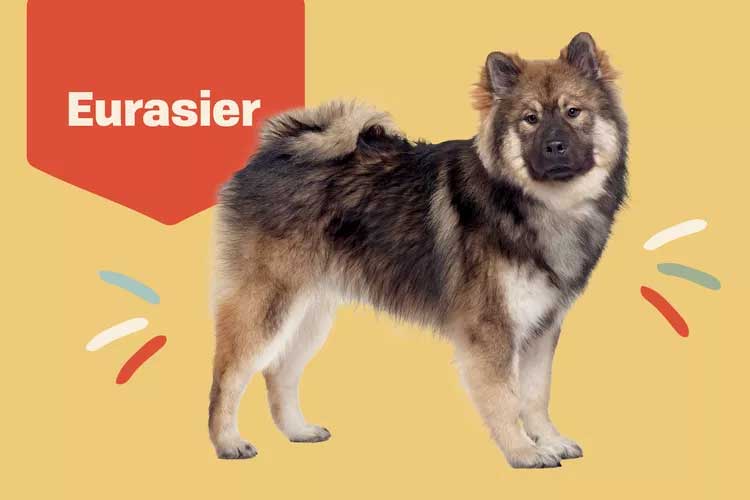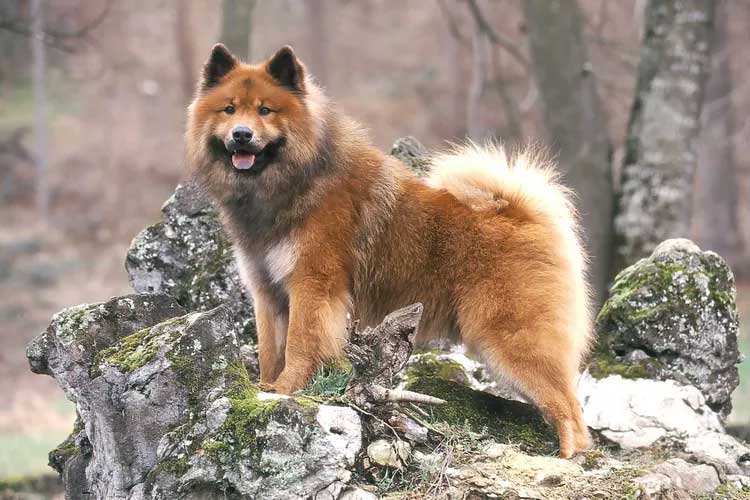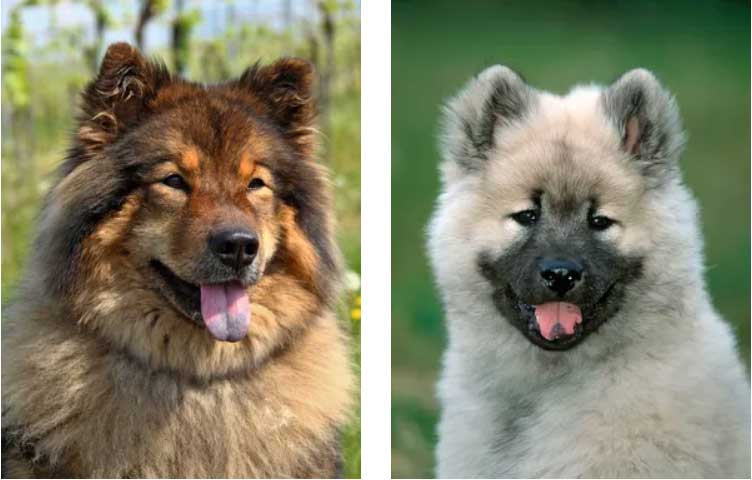The Eurasier is a calm, thoughtful, and confident dog who’s incredibly loyal to her family. Learn more about living with Eurasiers, a dog bred solely to be your furry BFF.

Eurasier Overview
| OFFICIAL NAME | Eurasier |
| COMMON NAME | Eurasier |
| PET HEIGHT | 19 to 24 inches |
| PET WEIGHT | 40 to 70 pounds |
| LIFESPAN | 12 to 16 years |
| GOOD WITH | cats, children, dogs, families, seniors |
| TEMPERAMENT | gentle |
| INTELLIGENCE | high |
| SHEDDING AMOUNT | seasonal |
| EXERCISE NEEDS | medium |
| ENERGY LEVEL | calm |
| VOCAL LEVEL | when necessary |
| DROOL AMOUNT | low |
| BREED GROUP | none |
| BREED SIZE | medium (26-60 lbs.) |
| COAT LENGTH | medium |
| COLORS | black, fawn, gray, red |
| PATTERNS | sable |
| OTHER TRAITS | apartment-friendly, easy to groom, easy to train, low prey drive, strong loyalty tendencies |
The Eurasier is a confident, calm, and gentle dog who is reserved when meeting strangers yet incredibly loyal to her family. Standing between 19–24 inches at the shoulder and weighing in between 40–70 pounds, the Eurasier was bred to be a companion dog and is happiest being just that—a loving part of the family.
Although she fits into almost any family, the Eurasier is a rare breed in North America. According to the United States Eurasier Club (USEC), only about 450 dogs live on the entire continent and only about 150 are in the U.S.
Appearance
One look at a Eurasier and you may think she's a chow chow or part Samoyed, and you wouldn't be wrong. The Eurasier is the result of intentional breeding, first between a chow and a "wolfspitz" (aka a keeshond). Then the Samoyed was introduced to enhance these pups' friendly nature. Even though she's a mix of these dogs, the Eurasier is her own breed.
Standing between 19–24 inches at the shoulder and weighing up to 70 pounds, the Eurasier has a double coat that's straight and of a medium length, though slightly longer around her neck and the back of her legs. Eurasier colors can be red, fawn, black, wolfgray, or sable. She may have black markings and, due to her chow chow lineage, her tongue may be purple or spotted.
On the other end of this medium-sized dog is a thick, high-set tail that's carried forward on the back, often in a tight curl.
Temperament
According to the breed club, the Eurasier is loving, intelligent, and loyal, and she's an integral part of her family. Though she doesn't need constant interaction, a Eurasier does want to be where the action is and she'll follow her family around to see what's going on."Eurasiers tend to be calm and self confident dogs, and they are extremely loyal and devoted to their immediate family," says Emily Wilson, DVM, veterinary expert with Fuzzy. "They are extremely observant dogs generally in regards to their surroundings, and they can be reserved with strangers initially."
As with most dogs, it's best to socialize your Eurasier puppy and train her early on so she adapts to different environments and situations. This will ensure she's as comfortable out in the world as she is at home. Socialization is especially important for Eurasiers, who can be uncomfortable around new people at first.

"Eurasiers are very thoughtful and perceptive, and [they] will take their time assessing each new person they encounter before deciding to which degree they will interact with the person," says Wendy Schuyler, president of the United States Eurasier Club. "They tend to maintain a certain level of reserve until they have gotten to know, like, and trust people outside of their family unit."
But, Schuyler adds, this reserved behavior varies with each dog. "Some Eurasiers are quick to enjoy making a new friend, while others take longer to warm up to a new person, and still others will have a tendency to remain reserved with most non-family members," she explains. "Eurasiers are not fearful, just cautious and discerning."
Living Needs
If you're looking for an amenable and adaptable dog, the Eurasier may be for you. "They are often very tolerant with younger children and are overall affectionate dogs," Wilson says.According to the USEC, a Eurasier dog easily fits into all types of families and lifestyles, from living with children and seniors to making herself at home in an apartment, house, or on a farm or ranch. She'll also get along well with other dogs or cats in the home, and she's always down for some playtime in the fenced backyard.
"Many Eurasiers live happily in multi-pet homes," Schuyler says. In fact, Eurasiers are sometimes called "cat charmers."

"Eurasiers tend to have calm energy as adults; that may be why cats are not offended by Eurasiers," Schuyler says. "At times, the Eurasier demeanor can be described as cat-like; they can be quite independent."
Because a Eurasier enjoys being an integral part of the family, she shouldn't be left alone for long. When she is on her own for short periods of time, your Eurasier will likely keep herself entertained with a favorite chew toy.
Schuyler says that first-time dog owners will do well with a Eurasier if they have spent time around other dogs and have a good understanding of dog ownership—and the training and responsibilities that come with it.
"It is recommended especially for first-time dog owners to be sure to attend puppy classes and basic obedience with their Eurasier," she adds.
Care
Caring for your Eurasier is fairly easy. Even though her coat is thick and fluffy, it's relatively low maintenance. A once-a-week brushing or combing, cleaning her eyes, checking her foot pads, and an occasional nail trim will keep your Eurasier healthy. She's not prone to doggy odor, so there's no need to bathe her often. As with all dogs, take the time at home to ensure your Eurasier's ears are free of infection and her teeth are brushed often.Because she's highly intelligent with a strong desire to be a part of the family, your Eurasier will take to training well. Like all dogs, consistent and positive reinforcement training throughout her life will help her be polite and well-behaved.
"Training methods using positive reinforcement and calm, confident leadership increases the dogs' self-confidence, exercises their body and mind, and further strengthens their bond with their human," Schuyler says.

Though she's calm inside the house, that doesn't mean the Eurasier doesn't enjoy stretching her legs. Wilson says these pups enjoy getting outside and going for walks, playing with other dogs, swimming, and even participating in dog sports.
"Eurasiers are not a working breed; their sole purpose is to be wonderful family pets," Schuyler says. "Some Eurasiers enjoy participating in companion events such as agility and obedience where the bond between dog and human is nurtured."
Health
Eurasiers have a lifespan of 12–16 years, and Wilson says they are generally healthy dogs. She does note that the breed has some orthopedic concerns to be aware of, including patellar luxation, hip dysplasia, and elbow dysplasia. "Thyroid disorders as well as exocrine pancreatic insufficiency have also been noted in the breed," Wilson adds.If you suspect your pup is developing any of these conditions, be sure to consult your veterinarian. Aside from these potential conditions, your Eurasier should visit the vet for regular checkups and vaccinations. You'll also want to talk to your vet about flea and tick prevention, depending on where you live.
History
The Eurasier is a relatively new breed. According to the breed club, Julius Wipfel is considered the founder of the breed and created these pups to pay homage to his former spitz dog. For about a decade, Wipfel worked to breed a dog who was intelligent, independent, and "wolf-like" in behavior. From that desire, the "wolf chow" was born, which eventually became the Eurasier.The breed was recognized by the German Kennel Club in 1973. Today, the breed is primarily found in Europe, where there are about 6,000 Eurasiers.
Fun Facts
The name "Eurasier" was chosen due to the breed's European and Asian lineage, according to the breed club. They're sometimes called "the Eurasian dog."If you see what looks like a white Eurasian dog, it's more than likely a Samoyed, as Eurasier's coats can't be pure white.